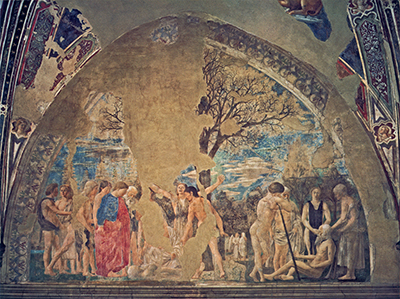The true cross's legend is the Death of Adam, a cycle of large murals designed by the clowns of San Francisco Cathedral in Arezzo.
After the death of the artist Bicci di Lorenzo before the completion of the art piece, he was asked to make the mural. On the right side, the dying old man Adam asks to visit the Archangel Michael with his son Seth to get oil to prevent him from dying. The style used on the art piece is early renaissance. In the centre of the distant background, Michael gives Seth a tree seed of sin. He then puts it in the mouth of his dying father to save his soul.
In the end, good and bad trees will come out of it, perhaps represented by a large tree in the centre of the mural. On the left, Adam's family lay him to rest. In the Early Ages, Adam's death was considered in many ways as the beginning of Christ's history. Some people think that the crucifixion tree that Jesus was crucified comes from the tree of right and wrong. The story of the true cross of Christ and the rediscovery of the mother of the Byzantine Emperor Constantine was particularly important at that time. Efforts were made to unite the churches of the west and east.
The great geometry of Francesca is fundamental in the composition of the painting. The tree forms a pillar at the perfect centre of the art piece and connects to the clear sky. The monochromatic treatment of colours and triangles in a digital cluster gives a unified visual sense of painting. Although the figures show the different stages of the three stories, Piero manages to integrate each scene into a continuous landscape seamlessly. The pale monotones of this photo, combined with the geometry of the human body, have influenced several artists of the twentieth century, including Balthus. The Christian art made in 1458, is currently located in San Francesco, Arezzo in Italy. It is an inspirational piece in the Christian community.




